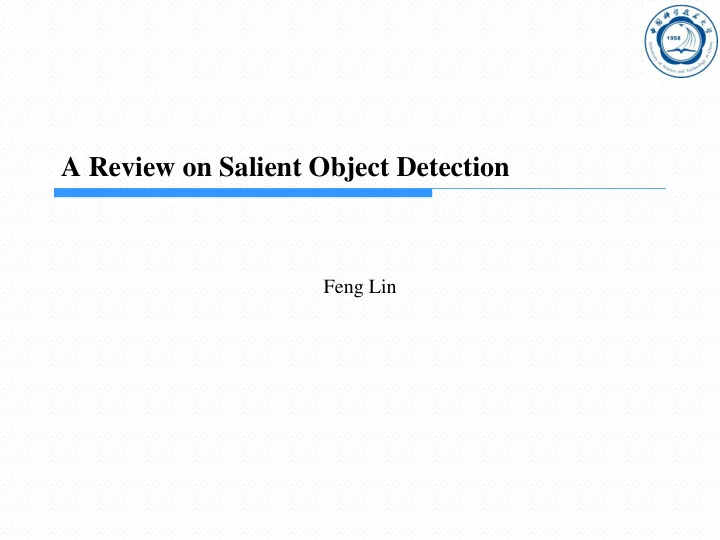

A Review on Salient Object Detection Feng Lin
Salient Object Detection Target Detect and segment salient objects in natural scenes a) good detection b) high resolution c) computational efficiency Metric F-score MAE (mean absolute error) S-measure*
Salient Object Detection Dataset ECSSD PASCAL-S SOD HKU-IS DUT-OMRON THUR-15K MSRA-10K MSRA-B (2k for training) DUTS (≈15k for training ) …
Salient Object Detection Method Two stages: (simultaneously perform the two stages in practice) a) detecting the most salient object b) segmenting the accurate region of that object Supervised or unsupervised method
Salient Object Detection Method Supervised Unsupervised
Salient Object Detection Deep Networks for Saliency Detection via Local Estimation and Global Search Combining local estimation and global search Utilize the geodesic object proposal (GOP) Regress saliency confidence Train: 51 × 51 patch, stride 10 pixels, by sliding window Predict precision and overlap rate (IOU) Test: stride 1 pixels Average top K candidate regions CVPR’15
Salient Object Detection Deep Networks for Saliency Detection via Local Estimation and Global Search
Salient Object Detection Visual Saliency Based on Multiscale Deep Features Enclose the considered region, neighboring regions and the entire image Run saliency model repeatedly over every region of the image CVPR’15
Salient Object Detection Visual Saliency Based on Multiscale Deep Features
Salient Object Detection Deeply Supervised Salient Object Detection with Short Connections CVPR’17
Salient Object Detection Deeply Supervised Salient Object Detection with Short Connections
Salient Object Detection Reverse Attention for Salient Object Detection Fine boundary, efficiency (45 FPS) and light weight (81 MB) Learn redundant features inside object without RA ECCV’18
Salient Object Detection Reverse Attention for Salient Object Detection
Salient Object Detection Reverse Attention for Salient Object Detection
Salient Object Detection Contour Knowledge Transfer for Salient Object Detection Automatically convert an existing deep contour detection model into a salient object detection model without using any manual salient object masks An alternating training pipeline to update the network parameters ECCV’18
Salient Object Detection Contour Knowledge Transfer for Salient Object Detection
Salient Object Detection Contour Knowledge Transfer for Salient Object Detection Contour to Saliency: utilize a large collection of unlabeled images to generate corresponding salient object masks, via Multiscale Combinatorial Grouping (MCG) Saliency to Contour: compute gradient on the binary region mask Alternating Training: use two different sets of unlabeled images (M and N) to interactively train the saliency branch and contour branch
WTA: Salient Object Detection set lambda = 0 in the first epoch, and 1 in the following epochs Contour Knowledge Transfer for Salient Object Detection
Salient Object Detection Contour Knowledge Transfer for Salient Object Detection
Salient Object Detection Detect Globally, Refine Locally: A Novel Approach to Saliency Detection Directly applying concatenation or element-wise operation to different feature maps are suboptimal (is cluttered) A spatial response map to adaptively weight the features maps for each position Consider the relations between the center point and its n × n neighbors Recurrent Localization Network + Boundary Refinement Network Contextual Weighting Module Recurrent Module Recurrent Localization Network CVPR’18
Salient Object Detection Detect Globally, Refine Locally: A Novel Approach to Saliency Detection Recurrent Module Absorb the contextual and structural information with the hidden convolution units Increase the depth of traditional CNNs without increasing the number of parameters
Salient Object Detection Detect Globally, Refine Locally: A Novel Approach to Saliency Detection
Salient Object Detection Detect Globally, Refine Locally: A Novel Approach to Saliency Detection
Salient Object Detection Pyramid Feature Attention Network for Saliency Detection ASPP + Channel Attention Block ( CVPR’18 ), actually Edge information as the previous works Impressive performance CVPR’19
Salient Object Detection Pyramid Feature Attention Network for Saliency Detection context-aware feature extraction module (CPFE)
Salient Object Detection Pyramid Feature Attention Network for Saliency Detection
Salient Object Detection A Simple Pooling-Based Design for Real-Time Salient Object Detection Use edge detection dataset, train alternatively Use PSP / modified PSP blocks CVPR’19
Salient Object Detection A Simple Pooling-Based Design for Real-Time Salient Object Detection PSPNet FAM
Salient Object Detection A Simple Pooling-Based Design for Real-Time Salient Object Detection
Salient Object Detection Cascaded Partial Decoder for Fast and Accurate Salient Object Detection Gaussian blur for the attention map: Partial decoder: a RFB-like block CVPR’19
Salient Object Detection Cascaded Partial Decoder for Fast and Accurate Salient Object Detection
Salient Object Detection Cascaded Partial Decoder for Fast and Accurate Salient Object Detection
Salient Object Detection Method Supervised Unsupervised
Salient Object Detection Weakly Supervised Salient Object Detection Using Image Labels MB+ generate training saliency maps (hard for low contrast and complex background) Multi-FCN simultaneously learns pixel-wise saliency and class distribution Initial saliency, predicted saliency and average top-three CAMs map + CRF Iteratively training (lowest validation error for each iteration) Finetune saliency prediction stream guided by offline CAM without annotations Multiple input scales (0.5, 0.75, 1) Probability maps are resized to raw size, summed up to get final probability (sigmoid) MS COCO with multiple class labels + MSRA-B and HKU-IS without annotations AAAI’18
Salient Object Detection Weakly Supervised Salient Object Detection Using Image Labels
Salient Object Detection Weakly Supervised Salient Object Detection Using Image Labels
Salient Object Detection Weakly Supervised Salient Object Detection Using Image Labels
Salient Object Detection Weakly Supervised Salient Object Detection Using Image Labels
Salient Object Detection Reference [1] Salient Object Detection: A Survey, TPAMI’17 [2] Deep Networks for Saliency Detection via Local Estimation and Global Search, CVPR’15 [3] Visual Saliency Based on Multiscale Deep Features, CVPR’15 [4] Deeply Supervised Salient Object Detection with Short Connections, CVPR’17 [5] Reverse Attention for Salient Object Detection, ECCV’18 [6] Contour Knowledge Transfer for Salient Object Detection, ECCV’18 [7] Weakly Supervised Salient Object Detection Using Image Labels, AAAI’18 [8] Detect Globally, Refine Locally: A Novel Approach to Saliency Detection, CVPR’18 [9] Pyramid Feature Attention Network for Saliency detection, CVPR’19 [10] A Simple Pooling-Based Design for Real-Time Salient Object Detection, CVPR’19 [11] Cascaded Partial Decoder for Fast and Accurate Salient Object Detection, CVPR’19
Recommend
More recommend